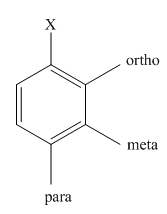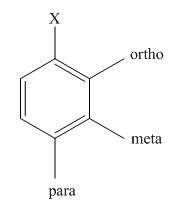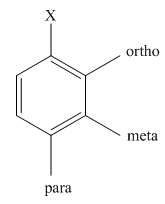
(a)
Interpretation:
The product of the monobromination of
Concept introduction:
Halogenation is the
The activating groups are the groups that have the ability to donate the electron density to the benzene ring. The deactivating groups are the groups that have the ability to withdraw the electron density to the benzene ring. The ortho and para directing groups are the activating groups while meta directing groups are deactivating groups.
The different positions with respect to group

(b)
Interpretation:
The product of the monobromination of aniline should be predicted.
Concept introduction:
Halogenation is the chemical reaction that involves the addition of one or more halogens to the compound. Bromination is the type of halogenations reaction that involves the addition of bromine to the compound. When bromine is added to a single position in the compound, the reaction is known as monobromination.
The activating groups are the groups that have the ability to donate the electron density to the benzene ring. The deactivating groups are the groups that have the ability to withdraw the electron density to the benzene ring. The ortho and para directing groups are the activating groups while meta directing groups are deactivating groups.
The different positions with respect to group

(c)
Interpretation:
The product of the monobromination of
Concept introduction:
Halogenation is the chemical reaction that involves the addition of one or more halogens to the compound. Bromination is the type of halogenations reaction that involves the addition of bromine to the compound. When bromine is added to a single position in the compound, the reaction is known as monobromination.
The activating groups are the groups that have the ability to donate the electron density to the benzene ring. The deactivating groups are the groups that have the ability to withdraw the electron density to the benzene ring. The ortho and para directing groups are the activating groups while meta directing groups are deactivating groups.
The different positions with respect to group

Want to see the full answer?
Check out a sample textbook solution
Chapter 27 Solutions
General Chemistry: Principles and Modern Applications (11th Edition)
- (a) A hydrocarbon isolated from fish oil and from plankton was identified as 2,6,10,14-tetramethyl-2-pentadecene. Write its structure.(b) Alkyl isothiocyanates are compounds of the type RN C S. Write a structural formula for allyl isothiocyanate, a pungent-smelling compound isolated from mustard.(c) Grandisol is one component of the sex attractant of the boll weevil. Write a structural formula for grandisol given that R in the structure shown is an isopropenyl group.arrow_forward(b) Describe the hazards of (i) trioxygen: (ii) hydroxide ion; (ii) hydrogen sulfide. (c) Explain why an aqueous solution of sodium sulfide has an odor of hydrogen sulfide. (d) (11) Reduction of H,CCHCHO with NABH4 gives a product different from that of catalytic hydrogenation (H2 /Ni). What are the products?arrow_forwardDraw the organic product formed when the followingcompounds undergo a substitution reaction: (a) acetic acid and1-hexanol; (b) propanoic acid and dimethylamine; (c) ethanoicacid and diethylamine.arrow_forward
- Draw the structures of the following compounds. (a) 1-isobutyl-4-isopropylcyclohexane; (b) tert-butylcyclopentane;(c) 3,3-diisopropyloctanearrow_forward1.When 2-heptyne was treated with H2SO4(aqueous) containing mercuric sulphate, two products, each having molecular formula C7H14O, were obtained in approximately equal amounts. (a) What are these two products and write down their structures (b) Write a complete reaction equation.arrow_forward(a) Give chemical tests to distinguish between the following pairs of compounds :(i) Ethanal and Propanal (ii) Phenol and Benzoic acid(b) How will you bring about the following conversions?(i) Benzoic acid to benzaldehyde (ii) Ethanal to but-2-enal (iii) Propanone to propeneGive complete reaction in each case.arrow_forward
- (a) Account for the following :(i) Cl – CH2COOH is a stronger acid than CH3COOH.(ii) Carboxylic acids do not give reactions of carbonyl group.(b) Write the chemical equations to illustrate the following name reactions:(i) Rosenmund reduction (ii) Cannizzaro’s reaction(c) Out of CH3CH2 – CO – CH2 – CH3 and CH3CH2 – CH2 – CO – CH3, which gives iodoform test?arrow_forwardDraw the organic product obtained by hydroboration-oxidation of each of the following alkenes: (a) trans-2-pentene, (b) 2-tert-butyl-3,3-dimethyl-1- butene, and (c) 1-methylcyclohexene. Having done this, draw the product of the acid-catalyzed hydration of these same alkenes. How do the reaction products differ?arrow_forwardBiphenyl has the following structure.(a) Is biphenyl a (fused) polynuclear aromatic hydrocarbon?(b) How many pi electrons are there in the two aromatic rings of biphenyl? How does this number compare with that for naphthalene?(c) The heat of hydrogenation for biphenyl is about 418 kJ>mol (100 kcal>mol). Calculate theresonance energy of biphenyl.(d) Compare the resonance energy of biphenyl with that of naphthalene and with that of two benzene rings. Explain thedifference in the resonance energies of naphthalene and biphenyl.arrow_forward
- Draw the structures of: (a) 1-ethenyl-3-nitrobenzene; (b) (1-methylpentyl)benzene; (c) 2-methyl-1,3,5-trinitrobenzene.arrow_forwardThe name of the parent six-membered sulfur-containing heterocycle is thiane. It is numbered beginning at sulfur. Multiple incorporation of sulfur in the ring is indicated by the prefixes di-, tri-, and so on. (a) How many methyl-substituted thianes are there? Which ones are chiral? (b) Write structural formulas for 1,4-dithiane and 1,3,5-trithiane. (c) Which dithiane isomer (1,2-, 1,3-, or 1,4-) is a disulfide?(d) Draw the two most stable conformations of the sulfoxide derived from thiane.arrow_forwardCitronellol ((3R)-3,7-dimethyloct-6-en-1-ol, C10H20O) is an organic fragrance found in the oil extracted from lemon grass. a) Name the two functional groups present in the molecule. b) When a few drops of bromine dissolved in hexane is added to a sample of citronellol the brown colour of the bromine rapidly disappears. i. What type of chemical reaction has occurred? ii. Draw the structure of the product formed. iii. Name the product. c) The product formed when citronellol is heated with a mixture of potassium dichromate and sulfuric acid gives a yellow/orange precipitate when shaken with Brady’s reagent (2,4-dinitrophenylhydrazine). It also shows a positive result with Fehling’s solution. i. What type of chemical reaction has occurred ? ii. What type of functional group is present in the product? d) Explain the type of stereoisomerism which may occur in citronellol.arrow_forward
 ChemistryChemistryISBN:9781305957404Author:Steven S. Zumdahl, Susan A. Zumdahl, Donald J. DeCostePublisher:Cengage Learning
ChemistryChemistryISBN:9781305957404Author:Steven S. Zumdahl, Susan A. Zumdahl, Donald J. DeCostePublisher:Cengage Learning ChemistryChemistryISBN:9781259911156Author:Raymond Chang Dr., Jason Overby ProfessorPublisher:McGraw-Hill Education
ChemistryChemistryISBN:9781259911156Author:Raymond Chang Dr., Jason Overby ProfessorPublisher:McGraw-Hill Education Principles of Instrumental AnalysisChemistryISBN:9781305577213Author:Douglas A. Skoog, F. James Holler, Stanley R. CrouchPublisher:Cengage Learning
Principles of Instrumental AnalysisChemistryISBN:9781305577213Author:Douglas A. Skoog, F. James Holler, Stanley R. CrouchPublisher:Cengage Learning Organic ChemistryChemistryISBN:9780078021558Author:Janice Gorzynski Smith Dr.Publisher:McGraw-Hill Education
Organic ChemistryChemistryISBN:9780078021558Author:Janice Gorzynski Smith Dr.Publisher:McGraw-Hill Education Chemistry: Principles and ReactionsChemistryISBN:9781305079373Author:William L. Masterton, Cecile N. HurleyPublisher:Cengage Learning
Chemistry: Principles and ReactionsChemistryISBN:9781305079373Author:William L. Masterton, Cecile N. HurleyPublisher:Cengage Learning Elementary Principles of Chemical Processes, Bind...ChemistryISBN:9781118431221Author:Richard M. Felder, Ronald W. Rousseau, Lisa G. BullardPublisher:WILEY
Elementary Principles of Chemical Processes, Bind...ChemistryISBN:9781118431221Author:Richard M. Felder, Ronald W. Rousseau, Lisa G. BullardPublisher:WILEY





